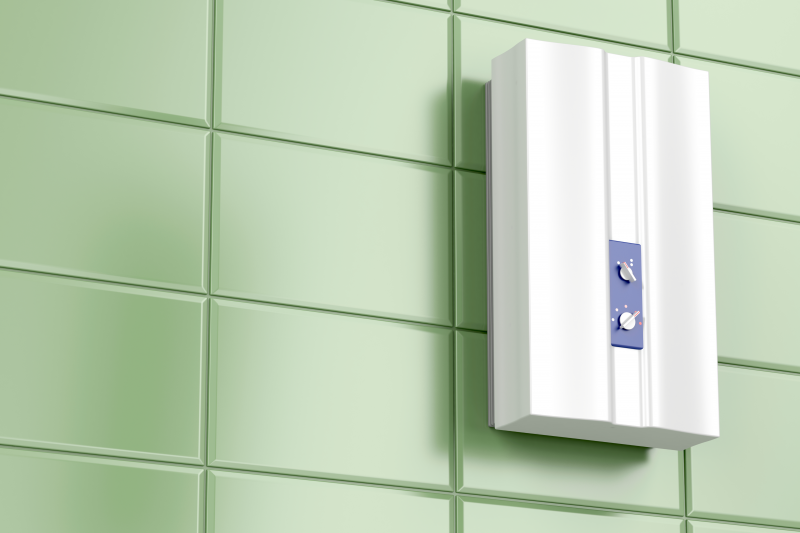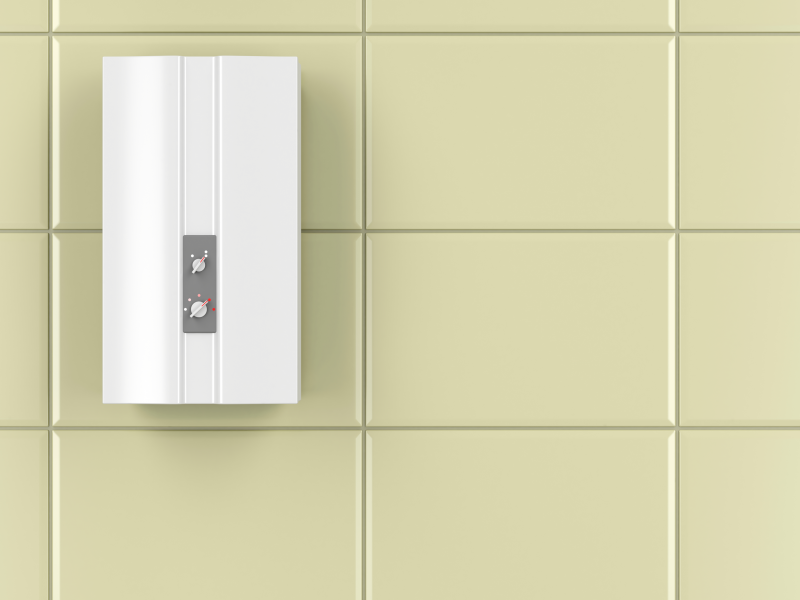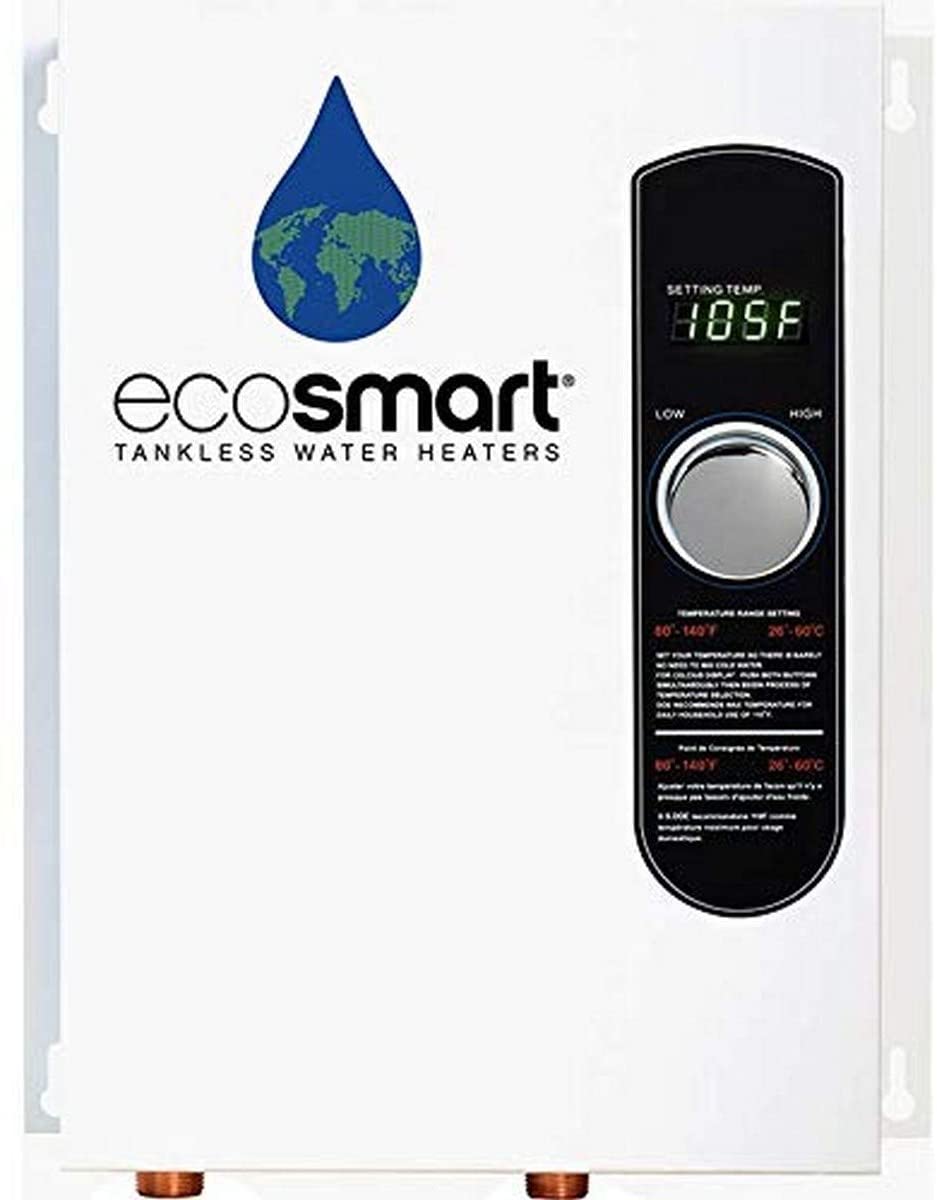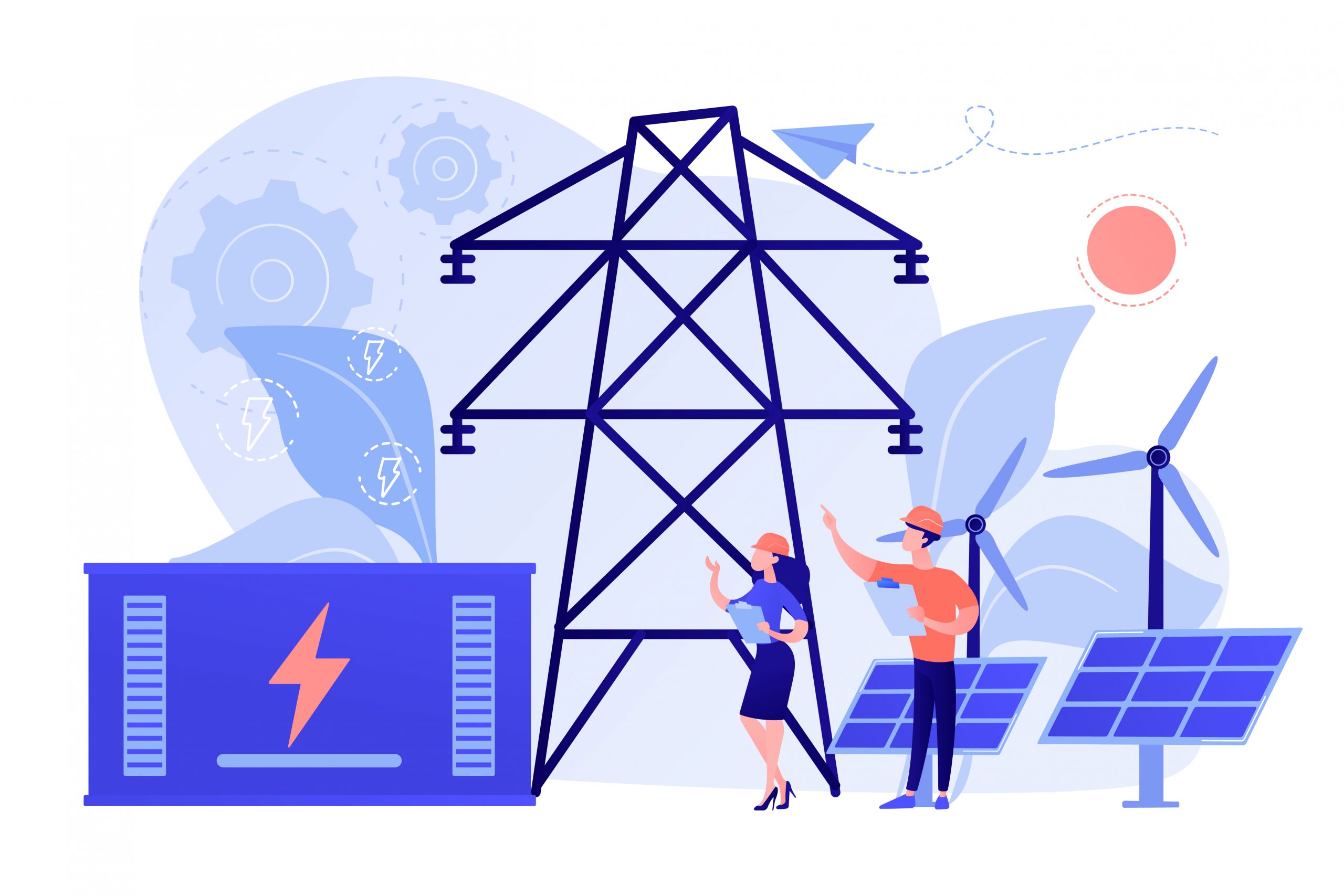Best electric tankless water heaters in 2022
|
|
|
|
|
|---|---|---|---|
Best for mid-size homes– 18 kW |
Best for large families
|
Best point-of-use/RV– 1.4 kW |
Best US-designed
– 18 kW |
For most homes, tankless electric water heaters are the most effective type of heater available.
Compared to old-fashioned tank heaters and gas options, electric models are more efficient, longer-lasting, less expensive, smaller in size, and will reduce your monthly energy bills—as you’ll only pay for the hot water you need.
Tankless electric water heaters offer instant heating, meaning you can enjoy warm water less than 10 seconds after turning on the tap. Many models are also near-silent, so say goodbye to banging pipes and gas firing sounds.
What’s on this page?
The idea of a heater that’s cheaper to purchase, install, and operate sounds like a no-brainer. But choosing from the wide array of current heaters isn’t so easy. Use our reviews to find the best electric water heater for your home:

What’s the best electric tankless water heater?
At a glance? Our favorite overall tankless electric water heater is Ecosmart ECO 18:
- Never run out of water with on-demand heat
- Runs multiple appliances without flow issues
- Beats competitors on price with equal features
- Whole-house or point-of-use installation options
- Lifetime warranty & thousands of 5-star reviews
How to choose an Electric Tankless Water Heater
Deciding on 4 essential electric heater features will help identify the ideal tankless water heating system for your home. These are: flow rate, heating power, heater type, and brand reputation.

Flow rate
Flow rate is the output of a heater, listed in gallons per minute (GPM). Choose a heater with a high enough flow rate for your home’s needs. We recommend tankless heaters with a flow rate of at least 4 GPM.
A single shower or laundry machine requires about 2 GPM, and most 2-bathroom homes can operate comfortably on 4 GPM. Larger houses may need up to 10 GPM.
Heating power & efficiency
Heating power is the amount of energy an electric heater can deploy, listed in kilowatts (kW). For the majority of homes, we recommend a heating power of at least 18 kW.
Higher kW models quickly heat large amounts of water but need multiple circuit breakers and 240 volts. Lower kW heaters have less power but make fewer demands on your home’s wiring.
All electric heaters are highly energy-efficient and operate with minimal wastage. Most gas tankless water heaters can only achieve 80-90% efficiency, while electric models often reach 98% or higher.
Remember that heating power is affected by source water temperature. Heaters in colder climates may not meet manufacturer performance claims, so you may need to invest in a unit with a higher kW.
Heater type
There are two main types of tankless water heater: point of entry and point of use. Point of entry (POE) heaters are installed on a mains water line and provide heating for an entire home. They need high heating power and a strong flow rate to send water to multiple appliances.
Point of use (POU) heaters are installed by a single faucet or shower and heat water for that appliance only. POU products are smaller, less expensive, and need less electrical power.
POE heaters are more popular and convenient but require a modern service panel and wiring, so they’re not appropriate for every home. POU heaters may be more suitable for guest cottages, cabins, or homes with a low incoming water flow.
Warranty and brand reputation
Analysis from the US Department of Energy shows that most tankless electric heaters will last for around 20 years with proper installation and maintenance—far longer than the average tank heater.
Despite their longevity, it’s important to buy your heater from a brand with a reputation for reliability. Lifetime warranties and satisfaction guarantees are good ways to identify trustworthy manufacturers.
When comparing warranties, watch out for fine print restrictions. Many heater warranties are void if the unit is not installed by a licensed contractor.
Our top picks
1. Best Electric Tankless Water Heater for mid-size homes – Ecosmart ECO 18 Electric Tankless Water Heater
- Reviews: 4.5 out of 5 from 3700+ global Amazon ratings
Power: 18 kW/140 degrees
Flow rate: Up to 4.3 GPM
Efficiency: 99.8%
Type: POE | 240V | 2x40A breakers
Ecosmart ECO 18 review:
Small but mighty, the Ecosmart ECO 18 is the heater we think offers the best value for homes with a maximum of 2 bathrooms. The ECO 18 heats up to 140 Fahrenheit and provides 4.3 GPM in mild climates, which is ample for two standard appliances running simultaneously. We like how the heater’s sensor activates at just 0.25 GPM, which means it won’t shut off at unwanted times, such as when adjusting the hot water during a shower. A digital control and 99.8% efficiency rating ensure that the ECO 18 doesn’t feel inferior to the pricier and more well-known Stiebel and Rheem (below). Reviewers highlight how user-friendly and extremely quiet the ECO 18 is, while Ecosmart provides customers with a limited lifetime warranty for peace of mind. To top things off, the ECO 18 is ETL and Water Quality Association-certified for safety. –Our Best Buy pick!
We recommend the Ecosmart ECO 18 for:
- Average-size homes (1-2 bathrooms)
- Energy saving
- Constant temperature (self modulating)
2. Best Electric Tankless Water Heater for larger families – Stiebel Eltron Tankless Water Heater Tempra 36
Reviews: 4.6 out of 5 from 950+ global Amazon ratings
Power: 36 kW/140 degrees
Flow rate: Up to 7.5 GPM
Efficiency: 99%
Type: POE | 240V | 3x50A breakers
Stiebel Eltron Tempra review:
The Stiebel Eltron Tempra is the most well-reviewed tankless electric water heater on the internet—with good reason. It provides hot water in seconds and keeps a consistent flow thanks to self-modulating technology that automatically manages output during high-demand periods. This version of the Tempra provides an impressive 36 kW and up to 7.5 GPM, which is the most powerful heater on this page. It can run 4 showers simultaneously and exceeds the daily needs of most users, including those living in colder areas of the country. All that power does however mean the Tempra requires three 50 amp circuit breakers to safely run, which may require alterations to your wiring. The Steibel is manufactured in Europe to ANSI-certified standards and has a digital screen with programmable memory. Not to mention it’s super energy efficient and near-silent! The well-reviewed warranty includes 7 years of leak coverage—but is void without a professional install.
We recommend the Stiebel Eltron for:
- Consistently high water temperature
- Colder climates
- Larger families (3+ bathrooms)
Or read our full review of the Stiebel Eltron Tempra
3. Best point of use / RV / Mini Electric Water Heater – Bosch Electric Mini-Tank Water Heater Tronic 3000 T 4-Gallon
Reviews: 4.5 out of 5 from 5,900+ global Amazon ratings
Power: 1.4 kW/145 degrees
GPH: 4-gallon tank | refills at 6.8 gallons per hour (GPH)
Efficiency: 98%
Type: POE | 120V | 12A outlet
Bosch Tronic review:
The Bosch Tronic 3000 is not actually a tankless heater! But we think it’s a perfect point-of-use device from a renowned German company. With a 4-gallon tank, the Tronic 3000 is small enough to fit anywhere and reviews suggest there’s no delay in providing hot water—meaning it effectively operates like a tankless unit. It will run low if overused, but when connected to a single appliance in shower stalls, cabins, or RVs, its sub-hour refill time means that shortages shouldn’t be a serious problem. We recommend the Bosch and other POU heaters for guest accommodation, as a secondary heater, or in properties with a very low incoming GPM. Because it plugs into a standard 120V outlet, it’s a versatile unit with endless potential applications. On the downside, its low power does mean flow rate may be more impacted by incoming water temperature.
We recommend the Bosch Tronic for:
- Single appliance use (shower, kitchen sink)
- Lower electrical demands
- RVs, sail boats, cabins
4.  Best US-designed Electric Tankless Water Heater –
Best US-designed Electric Tankless Water Heater –
Rheem RTEX-18 18kW 240V
Reviews: 4.5 out of 5 from 775+ global Amazon ratings
Power: 18 kW/140 degrees
GPM: Up to 4.4 GPM
Efficiency: 99.8%
Type: POE | 240V | 2x 40A breakers
Rheem RTEX review:
Rheem is one of the most recognizable names in tankless heaters, having pioneered new heating technologies since the 1930s. RTEX is the brand’s standard tankless electric range, with this 18 kW unit being the most popular option. Its self-modulating brass-topped heating elements offer both consistent heat and an amazing 99.8% efficiency. For a small price increase over the Ecomsart ECO 18, you also get a slightly better flow rate in most temperature conditions. We like the Rheem RTEX’s 5 Year Limited Warranty and clear display with a single-degree temperature dial, as well as how the heating elements come pre-threaded for easier replacement. Like the other point-of-entry heaters above, the RTEX-18 needs to be installed on 240 volts and 2x 40 amp circuit breakers to safely function.
We recommend the Rheem RTEX for:
- Average-size homes (1-2 bathrooms)
- Energy saving
🔥Other popular Electric Tankless Heaters
Best for bathrooms – ECOTOUCH Tankless Water Heater
One of the smallest tankless heaters on the market, the ECOTOUCH can be used as either a point-of-use or point-of-entry system under the right conditions. One-touch buttons and a clear digital display control a copper heating element that produces up to 1.5GPM and 116 degrees with just 2% energy wastage. The ECOTOUCH is a great option for a single shower.
Best for apartments – EcoSmart ECO 11 Electric Tankless Water Heater 13KW at 240 Volts with Patented Self Modulating Technology
The 13 kW version of our Best Buy pick, the Ecosmart ECO 18. This ECO 11 heater pulls off the feat of providing up to 3.1 GPM (enough for an apartment or small townhome) while running on a single 60A breaker. This makes it relevant for those who want to take advantage of lower electric bills, but can’t run a 240-volt system. Affordable, small, and stylish enough to install in a visible spot.
Popular POU – Titan N-120 Electric Tankless Water Heater
An alternative to the Bosch Mini Tronic 300 is this Titan N-120. Able to run on 120 volts, it’s a versatile point-of-use heater that’s capable of handling a single appliance at a time. While it’s unlikely to cut it in colder climates, the Titan is a longstanding choice for simple, affordable water heating.
Tiny proportions – Marey Power Pak Plus Tankless Electric Water Heater
Another highly affordable point-of-use heater, the Marey Power Pak Plus packs an impressive 2 GPM into a tiny casing that can be installed directly into a shower stall or kitchen cupboard.
Best infrared heating – Sio Green SIO18 Infrared Electric Tankless Water Heater
Unlike the vast majority of electric tankless water heaters, which use copper coils to heat water, the Sio Green SIO18 contains an infrared laser that’s used to heat quartz crystals. Infrared heaters have a reputation for providing very high water temperature over a long lifespan.
Popular in RVs – Stiebel Eltron DHC-E12 Tankless Electric Water Heater
This simple heater from Stiebel Eltron might not match the heating power of their Tempra unit, but it’s a good option for homes, boats, or RVs that only need limited amounts of hot water. A flow rate of 2 GPM should be ample for most showers.

Best Electric Tankless Water Heater – Buying guide
How does a tankless electric water heater work?
To quickly raise water temperature and create the impression of endless hot water, tankless heaters contain flow sensors, which detect when an outlet in your home is turned on.
When the sensor is tripped, the heater supplies electricity to the heating element, which is either a series of copper coils or an infrared device. The opposite happens when an outlet in the home is turned off, meaning that no energy is wasted at hot water creation is truly “on demand.”
Copper coils are the most common way of raising water temperature in tankless water heaters and are also often the cheaper of the two main heating elements. The more coils within a heating unit, the hotter water can get.
Infrared technology tends to be more expensive than the traditional copper coil, but they aren’t necessarily better.
Selecting the right size tankless water heater
The most important consumer decision when buying a tankless water heater is unit size. the size of a heater determines its flow rate, which in turn determines the number of appliances the unit can simultaneously supply.
It’s easy to find out what flow rate your home requires. Simply make a list of your plumbed outlets and appliances, and each of their individual flow rates. Some appliances will list rates on their casing/service panel, while others require a quick Google search or guestimation.
Average flow rates for common appliances are:
- Kitchen faucet: 2.5 gallons per minute
- Bathroom faucet: 2.5 gallons per minute
- Shower Head: 2.5 gallons per minute
- Toilet: 1.6 gallons per flush
- Washing machine: 15-25 gallons per load
- Dishwasher: 8 gallons per load
Source: watereducation.org
No home runs all of its appliances at the same time, so think about the daily maximum flow rate you’ll need. Most homes can run happily on tankless water heaters with flow rates between 4-10 GPM.
For small to average-sized homes, we recommend the Ecosmart ECO 18, which delivers a flow rate of up to 4.3 GPM. For larger houses, our pick is the Stiebel Eltron, with a flow rate of up to 7.5 GPM.
When judging flow rate, consider the ambient temperature of your water source. The lower the temperature of incoming water, the harder the unit will need to work to keep the desired temperature and flow of water.
Most heater companies supply information on flow rate based on ideal incoming water temperature, so be sure to factor in the specifics of your environment.
Tell me the difference between a tankless and tanked water heater
Costs
Electric heaters without tanks are generally less expensive than gas or tank models, both in unit price and monthly costs.
Even where the base price of electric tankless water heaters is higher, the investment is usually offset by savings on utility bills.
Without a tank to store water, electric heaters increase their energy efficiency by only heating what’s necessary and reducing wastage (known in the industry as standby heat loss).
Hot water demand
Even though tanked water heaters have the ability to store up hot water, they’re more likely to leave you shivering in the shower or frustrated at the kitchen sink.
When the tank in a traditional heater runs low, it can take a long time for the system to replace the supply. This can leave you fretting about how much hot water has been used during a day.
A tankless water heater supplies water on-demand to create the impression of endless hot water (assuming you have the correct flow rate for your needs). This is especially true in heaters without tanks that have an advanced flow control function, to help modulate the release of hot water.
Size and energy savings
A conventional water heater has large, multi-gallon tanks and bulky heating elements. This means they need lots of space—usually a laundry cupboard or boiler room. Modern heaters can be mounted on a wall, or even inside a shower cubicle.
Conventional tank-style water heaters are always operating, which eats up fuel and leaves a mark on your energy bills. A tankless unit only turns on when there’s a demand for hot water, meaning that you should see savings on your electricity bill.
Lifespan
Almost all tankless units will last for longer than tank heaters due to fewer moving parts and a more efficient heating process. The best electric tankless water heaters are designed to last up to 20 years, while conventional type water heaters have a service life expectancy between 8 and 12 years.
This difference in design also means that a tankless water heater can usually be serviced or replaced more easily than older models.
Maintaining a tankless heater
Heaters come with basic filter screens to help keep dirt and particulate matter out of the unit. Clean this filter screen regularly to avoid clogging.
Flushing or “de-liming” a heater is an important maintenance task to keep the element inside a water heater clean of chemical deposits and optimally functioning. This is usually done with vinegar or bleach.
We recommend installing a water filter [LINK] on the incoming water line to protect the unit. Many people also choose to add water softener [LINK] to reduce the number of corroding minerals running through the water heater.

FAQ – Best Electric Tankless Water Heater
Are electric tankless heaters any good?
Yes! These devices represent cutting-edge heater technology, bringing several benefits over gas or tank boilers. Across the developed nations, electric tankless water heaters are slowly replacing gas and tank systems every day.
A tankless water heater removes standby losses, which means less environmental impact and a lower electric bill.
With the right system, you never run out of hot water (we love the Stiebel Eltron’s self-modulating technology). Electric systems are also far less likely to break down. Even if there is a problem with your heater, you won’t have to deal with the serious leaks that can occur in large gallon tanks.
What is the downside of an electric tankless water heater?
In a large home with multiple bathrooms, a traditional hot water heater with a big tank may offer a better flow rate. Places with very low natural gas prices may also see less of a difference in long-term costs between gas and electric bills.
However, most homes don’t need super-high flow rates and aren’t able to take advantage of unusually low gas bills. If you have 1-3 bathrooms and an average set of kitchen appliances, an electric tankless water heater is more than likely to meet your needs.
Are electric tankless water heaters efficient?
A tankless water heater only heats water when it’s needed, allowing for minimal energy waste. The same is true for gas tankless heaters, but the efficiency of natural gas units vary from 80 to 93 percent, whereas electric models tend to range between 90 to 100 percent. Our Best Buy pick, the Ecosmart ECO 18, offers 99.8% efficiency.
Thanks to this near-zero energy wastage, tankless electric water heaters will lower your household energy bills drastically—up to as much as 34-40% annually.
Do electric tankless water heaters work in cold climates
The flow rate (GPM) of tankless water heaters is impacted by the temperature of the supply water. Colder climates mean that a heater will have to use more energy to create heat, which in turn lowers the unit’s maximum capacity. If you live somewhere very cold, you may want to think about a larger gas unit.
What is the best electric tankless water heater for RVs?
If you’re RV is able to run a non-portable electric heater, we would recommend the Bosch mini or the Titan—both of which run on 120V.
Do electric tankless water heaters need to be vented?
Unlike gas models, there is no carbon monoxide byproduct created by heating water. This means that no vent is required. As a result, electric tankless water heaters are considerably easier to install than gas models.
How to install a tankless electric water heater
All of the heaters featured on this page can be DIY installed, and reading comments from previous consumers suggests that only a basic amount of know-how is necessary.
However, it’s important to check warranty conditions carefully, as DIY installs may void any commitments from the manufacturer.
Calling in a professional becomes more necessary when you need to make adaptations to your home’s wiring to accommodate your new heater. Older homes transitioning to electric heat may need to have extra circuit breakers installed, which shouldn’t be attempted without expertise.
Another thing to consider when installing a heater is the distance between the unit and the appliance outlets. Longer distances between the faucet and the water heater increase tension in the piping system and may mean that special pipe insulation is needed.
Read on! More information on Water Heaters
Affiliate Disclaimer: Cleancoolwater.com is proud to be a reader-supported website. To keep our content free, we may earn small commissions when you click on a link or buy products through our pages. Commissions do not affect our review process.















